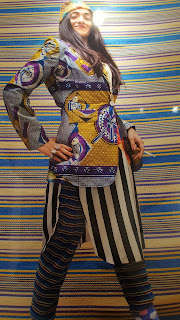Both artists set out to capture the vibrancy of youth culture, both artists are happy to provide props for their guests to pose with, and both create works that are as joyful as the viewer as they appear to have been for the subject. Sidibe, who passed in 2016, was born a good 25 years before Hajjaj appeared in Larache, Morocco in 1961 and it sometimes seems like Hajjaj's works take the template handed down by the Malian snapper and imbue it with the pop art stylings of Andy Warhol. Hajjaj has even been called the "Andy Warhol of Marrakech".
M. (2010)
Jenny Bikin' (2015)
Hajjaj may not paint Campbell's soup cans but he does surround the biker girls of Marrakech, and the rest of his portraits, with a selection of tins that look very much to come from the Warhol school. I didn't spot any soup containers but a quick inventory showed up tomatoes, orange juice, mackerel, tuna, beef, Coca-Cola, Pepsi, and even Gingerella. Gingerella is the drink I once posted about consuming on Facebook that so infuriated one 'friend' that he told me to start a blog so if you're fed up of these you can blame Gingerella. It's a nice drink*
Hajjaj moved from Morocco to the UK at the age of 12 and has spent the rest of his life travelling between the two countries and cultures. It seems to me that like many who call two different places home he's able to view the familiar through a stranger's eyes and to view the strange through familiar eyes. He's become particularly interested in performance of all sorts. Musicians, athletes, and, in the first room of this show, the Kech, or henna, girls of Marrakech whose mix of borderline traditional north African clothing with Western branding and motorcycle fetishisation seem like something Hajjaj would've invented if they hadn't beaten him to it.
Khadija (2010)
H.R.H. Alia (2016)
Motobecane (2019)
Though the Kech girls are real enough it seems that Hajjaj has had some input in to both the way they're dressed and the 'Motobecane' they're all posing atop. Hajjaj is like a benign control freak in that not only does he pose the photographs and take them but often he designs the clothes worn in them. He's also designed the motorbike, a series of dolls, and a live video which plays out over quite some time with various different Moroccan musicians, on a series of screens, getting up to strut their stuff. Luckily, he's also designed, and provided, a rather comfortable looking sofa for you to sit on and soak up the action. It's a neat idea and something other artists, and other galleries, could learn from.
Kesh Angels Couture Doll (2006)
Rider (2010)
My Rockstars Experiment Vol. 2 (2017)
Michael Garnette Sittin' (2014)
As you watch, and listen to, these lesser known Moroccan artists play you can take in more of Hajjaj's brightly coloured outfits and confident poses on the surrounding walls. It was good to see Afrikan Boy (who'd I'd seen putting in a great performance at last year's Camberwell Fair) giving grime props to both Woolwich and Nigeria amongst the more traditional Moroccan sounds.
Afrikan Boy Sittin' (2013)
Abimaro & Lakwena (2013)
Ayanna (2013)
The last room revealed a further, if not entirely unsurprising, diversification of Hajjaj's oeuvre. Socks, hats, and shades all done up to look one part high street fashion store one part art exhibition. Hajjaj mixes mediums as easily as he does cultures. While his work is bright and fun to look at it seems also that he's trying to make us think about how we view other cultures or even how we view our own culture. Or to even question problematic notions of ownership in culture at all. That he can do this while putting a smile on our faces as broad as that of the subject of 2013's Hindi Rockin' means I'll tip my black and red polka dot beanie to him. Here's hoping Somerset House can make it a hat-trick of great African photography exhibitions next year.
M.R.S. Socks (2017)
M.R.S. Hats (2017)
M.R.S. Shades (2017)
Hindi Rockin' (2013)
Bellydancer (2012)
*This blog received no sponsorship from Gingerella whatsoever (but the blogger is available for further discussion).




















No comments:
Post a Comment